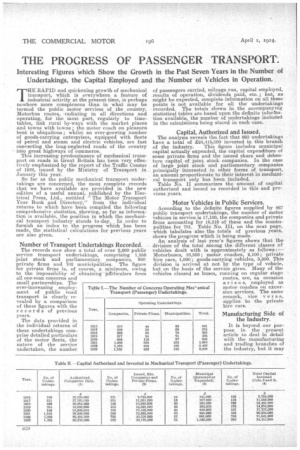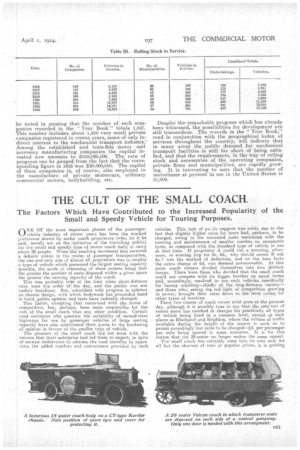THE PROGRESS OF PASSENGER TRANSPORT:
Page 14

Page 15

If you've noticed an error in this article please click here to report it so we can fix it.
Interesting Figures which Show the Growth in the Past Seven Years in the Number of Undertakings, the Capital Employed and the Number of Vehicles in Operation.
THE RAPID and quickening growth of mechanical transport, which is everywhere a feature of industrial activity at the present time, is perhaps nowhere more conspicuous than in what may be termed the public motor services of the country. Motorbus routes, -radiating in all directions and operating, for the most part, regularly to timetables, link rural by-ways with the market places and towns with towns; the motor coach on pleasure bent is ubiquitous ; whilst an ever-growing number of goods-carrying enterprises, equipped with fleets of petrol and steam and electric vehicles, are fast converting the long-neglected roads of the country into great highways of commerce.
This increasing predominance of mechanical transport on roads in Great Britain has been very effectively emphasized by the report of the Traffic Census of 1922, issued by the Ministry of Transport in January this year. So far as the public mechanical transport undertakings are concerned, the most complete records that we have available are provided in the new edition of a useful annual, published by the Electrical Press, Ltd., entitled "The Motor Transport Year Book and Directory," from the individual returns to Which have been compiled the following comprehensive statistics, showing, so far as information is available, the position in which the mechanical transport industry stands to-day. In order to furnish an index to the progress which has been made, the statistical calculations for previous years are also given.
Number of Transport Undertakings Recorded.
The, records now show a total of over 2,600 public service transport undertakings, comprising 1,556
joint stock and parliamentary companies, 950 private firms and 102 municipalities. The figure for private firms is, of course, a minimum, owing to the impossibility of obtainingptrticulars from all one-man concerns and
small partnerships. The
ever-increasing employTable I.—The Number of Con
ment of public road Transport (Passeng transport is clearly revealed by a comparison of these figures with the records of previous years.
The data provided in the individual returns of these undertakings comprise detailed particulars of the motor fleets, the nature of the service undertaken, the number of passengers carried, mileage rim, capital employed, results of operation, dividends paid, etc. ; but, as might be expected, complete information on all these points is not available for all the' undertakings recorded. The totals shown in the accompanying statistical tables are based upon the definite inforrnation available, the number of undertakings included in the calculations being stated in each case.
Capital, Authorized and Issued.
The analysis reveals the) fact that 993 undertakings have a total of 224,415,000 invested in this branch of the industry. This figure includes municipal capital actually expended, the capital expenditure of some private firms and the issued share and debenture capital of joint stock companies. In the case of large joint stock and parliamentary companies principally interested in other forms of transport, an amount proportionate to their interest in mechanical transport only has been included. Table No. II summarizes the amount of capital authorized and issued as recorded in this and previous years.
Motor Vehicles in Public Services.
According to the definite figures supplied by 867 public transport undertakings, the number of motor vehicies in service is 17,100, the companies and private firms accounting for 16,319 of these and the municipalities for 781. Table No. III, on the next page, which tabulates also the totals of previous years, shows the progress which is being made.
An analysis of last year's figures shows that the division of the total among the different classes of vehicles dealt with is approximately as follows :— Motorbuses, 10,500; motor, coaches, 2,100; private hire cars, 1,000; goods-carrying vehicles, 3,500. This division is arrived at not by the type of vehicle, but on the basis of the service given. Many of the vehicles classed as buses, running on regular stage
routes, are, as occasion arise s, employed as cerns Operating Meeanical motor coaches on excur
er) Undertakings. sion services. The same
remark, vice vers a, applies to the private hire cars.
Manufacturing Side of the Industry.
It is beyond our purpose in the present article to deal in detail with the manufacturing and trading branches of the industry, but it may be noted in passing that the number of such 'companies recorded in the "Year Book" totals 1,847. This number includes about 1,200 very small private ,companies registered in recent, years, some of only indirect interest to the mechanical transport industry.' Among the established and bona-fide rnotoi and accessory manufacturing companies the capital invested now amounts to 2105,025,000. The rate of progress can be gauged from the fact that the corresponding figure in 1916 was 220,000,000. The capital of these companies is, of course, also employed in the manufacture of private motorcars, ordinary commercial motors, bodybuilding, etc. Despite' the remarkable progress which has already been witnessed, the possibilities for development are still tremendous. The records in the " Year Book," read in conjunction with the geographical index of services throughout the country, will indicate that in many areas the public demand for mechanical transport facilities is still far short of being satisfied, and that the requirements, in the way of rolling stock and accessories of the operating companies, private firms and municipalities, are rapidly growing. It is interesting to note that the number of motorbuses at present in use in the United States is 51,000.






















































